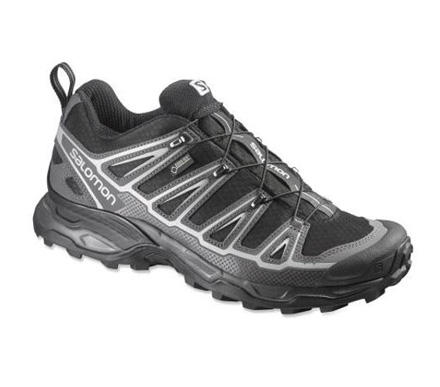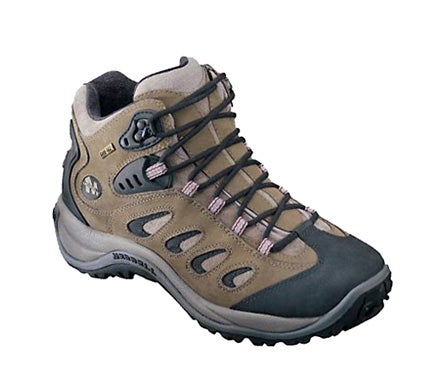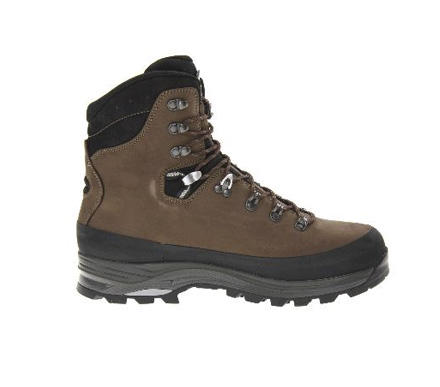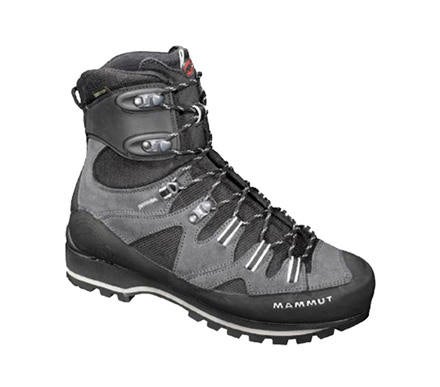Overwhelming. That’s how most describe their experience walking into a store trying to figure out how to choose hiking boots.
You want to find the right fit for you, that’s the first goal. You’ll most likely see Arc’teryx, Salomon, La Sportiva, and The North Face, the same companies that make your favorite jacket, all have a shoe on that wall you’re staring at. It all plays a factor in influencing your hiking boots decision whether you realize it or not.
We’re not saying you shouldn’t give those boots a fitting, but what we are saying is this: choosing a pair of hiking boots is one of the most complicated gear purchases you’ll make. That’s not said to talk you out of making a purchase, but to make you aware that you should never – we don’t say that lightly - feel pressured to rush the buying process. Yes, choosing the right boots is complicated, but it’s complicated for all the right reasons. We’re here to give you all the details about a step in the right direction.
The end goal in purchasing hiking boots is buying the boot that fits your specific outdoor needs (mountaineer, day hiker, backpacker, etc.) and finding the absolute best fit for your feet.
Ready to learn all there is to know about making a hiking boot purchase? Let’s get started.
Types of Hiking Boots
The term “hiking boots” is somewhat misleading, really. A hiking boot is only one category of the many types of footwear you’ll no doubt come in contact with while you’re in the thick of shopping. So, what else is out there?
Hiking Shoes – You’ll find this model of hiking footwear cuts off below the ankle and is very flexible, some even having technology that encourages proper stride-alignment for hard day hikes. If you’re an aspiring ultra-light backpacker, you can also use these shoes as a lightweight option for longer treks.

Hiking Boots – Ranging from mid- (at the ankle) to high-cut (above the ankle), this model is designed for those who enjoy a day or weekend trip. Best supporting lighter loads and requiring the shortest amount of break-in time, hiking boots are very flexible, but also lack the support and durability of backpacking boots, which brings us to the next category.

Merrell Reflex Mid GORE-TEX Hiker
Backpacking Boots – These boots are best suited for…you guessed it: backpacking. Providing the most support for both your ankles and feet, these are best suited for extended trips into backcountry areas and carrying heavy loads. These boots are well suited for all walks of life, whether on- or off-trail.

Mountaineering Boots – The toughest of the pack, these are designed for extreme travel and crampon fitting capabilities. Specifically suited for glacier travel, these boots are stiff, tough, and built to last.

Now that you know the kind of boots and shoes you’ll see out on the walls, how should they fit?
Great question.
The Cinderella Fit
We’re all familiar with the story of Cinderella, so we’ll skip to the end. The shot where Prince Charming slips the shoe on Cinderella and the shoe fits…perfectly. Now your hiking boot fitting experience might not be as romantic as this, but you’ll still want to find that “Cinderella fit”. No, Prince Charming won’t come chasing you down with your destined hiking boot, but who knows? Maybe you’ll cross paths with a stoic solo trekker who loves your shoes all the same. For most of you, you’ll have to try on boots -- lots of boots -- and probably some more boots after that. But the time you invest up front is far better than the possibility of time spent wishing your boots felt better on a 3-day backpacking trip. Here’s what you’ll need to do to find the best fit:
- Know Your Size
You might already know this, but it never hurts to have a refresher. Most retailers have equipment available to accurately measure your feet.
- Try Boots on Later in the Day
Feet tend to swell after an active day. Similarly, your feet can swell while you’re trekking along a hiking trail. All that to say, go try on boots later to account for possible (minor) swelling.
- Bring Orthotics with You
It’s that simple. If you wear orthotics, bring them with you, as they’ll play a big factor in the fit of your boots.
- Wear Socks You’ll Wear When You’re Actually Wearing the Boot
Think about wool or any other kind of sock you might wear when you’re out there hiking. The idea is to anticipate and simulate real hiking conditions.
- Always Try Brands You’ve Worn and Trusted
When you’re looking at the collection of boots, always try on brands you’ve worn and liked before. They’ll most likely stick to a consistent fit.
- Walk a Mile in Their Shoes
Take a stroll around the store. Maybe take a look at the jackets, or check out the fancy new outdoor gear the store has up on display. Get a general feel for how the boots fit to your feet. What’s the point in taking this extensive of an approach? You’re planning ahead and buying a boot that will a) be the best fit for your feet and b) protect your feet from having blisters, pinching, and bruised toenails that can plague your feet after a hike.
Hiking Boot “Feetures”
You’ll most likely see more hiking boot features than you can handle: durability, breathability, waterproofness, sole types, vegan, insulation, leather, warranties, etc. You get the point. Companies love to highlight what makes their boots better than the competition. Here’s a breakdown of what you’ll see and how you can make sense of it all:
- Full-grain leather is the most durable and abrasion resistant option of leather, while also retaining very good water repellency. You’ll often see backpackers sporting this approach for extended trips in rugged terrain and carrying hefty loads with them. Full-grain leather requires more break-in time than other options.
- Split-grain leather, often paired with nylon or mesh to retain a boot’s lightweight and breathable qualities, is a more cost-effective option, though it lacks the same quality in the durability, waterproofness, and abrasion resistance department compared to the above option.
- Nubuck Leather isn’t your typical leather, as it’s buffered to have a suede look and feel. It’s still leather, so it’s quite durable and resistant to both water and abrasion. More flexible than full-grain leather, this option also has a longer break-in time.
- Waterproofness is an important feature if you want an all-terrain boot. Plan on having dry feet running through patches of snow, getting caught in a thunderstorm or traversing through creeks if you purchase a pair waterproof hiking boots. Some people assume the waterproof protection of the GORE-TEX membrane means you sacrifice breathability. Guess again! With GORE-TEX Performance Comfort Footwear Technology, SURROUND® Footwear Technology, and Extended Comfort Footwear Technology you can have footwear that matches your exact needs. Not all waterproofness is created equal, however. Some shoes are better suited for high activity and warmer conditions, while others offer insulation to keep your little piggies warm in below freezing temps. We’ve got every kind of GORE-TEX boot for every kind of adventurer here.
If you’re looking for animal-friendly, you should ask about vegan hiking boot options out there that don’t use any animal products whatsoever. When thick socks won’t cut it, insulation is placed in boots for added warmth. When you’re hiking in colder settings like snow or on glaciers, this feature comes in clutch. Just be prepared to pay a premium for this premium benefit. The biggest determining factor in how stiff a boot will end up being lies largely on the midsole. EVA is the most used midsole material found in boots, offering more cushion, less weight, and a reasonable price tag. You’ll see varying densities of EVA depending on the boot and whether you want firmer support. Polyurethane is the second option, typically being more durable and firmer than its counterpart. It’s also most commonly found in backpacking and mountaineering boots for the aforementioned traits. Now, how supportive do you want your boot? Ryan Gosling supportive, or Mr. T supportive? Plates, or the Ryan Gosling option, are a thin and semi-flexible insert, placed between the midsole and outsole, great for protecting your feet from whatever the trail throws at your feet (rocks, roots, or any easily tripped on item). Now, they won’t yell at you like Mr. T, but shanks are thick inserts, normally found between the midsole and outsole, like plates, that add load-bearing stiffness to the midsole. Some cover half the length of the midsole, while others cover the whole thing. It varies between boots. For increased slip protection and grip on the mountain, look for a lug pattern (traction-giving bumps on the outsole/bottom of your boot), or a heel brake (the part of the shoe that keeps you from sliding during a deep descent), as part of the features on your desired boot. Crampons. They sound awkward, but they’ll save you so much breath once you’re actually on the mountain. Used on ice or rock climbing expeditions, crampons are metal spikes that give you extra support and traction. (Should we define what they are?) Different boots have different compatibilities, but the most common crampons are also the most self-explanatory. Strap-on crampons are compatible with almost every boot, while step-in crampons, the easiest, most precise and fastest system, are usually only compatible with mountaineering boots. The third crampon option is a hybrid crampon, which features a blend of the features offered in strap-on and step-in crampons. You’ll find this option is most compatible with backpacking boots and lightweight mountaineering boots, but not hiking boots. There was a lot of info there, but hopefully you’re starting to understand why buying a hiking boot isn’t a simple one-click internet purchase.
Take a Hike
So, where did the hiking boots get their start? It’s a complicated history, but one that’s worth telling. Take a step into the history of the hiking shoe on Experience More. You’ll most likely be looking for some ways you can get good use out of your boots. So, once they’re finally yours, here’s some inspiration to get outside.
- What it takes to get involved with a local hiking group.
- Other than boots, what else there is to wear when hiking.
- And how you can hike the Appalachian Trail.
It just takes a desire to do it! Have some unanswered questions about hiking boots? Maybe you’ve got a tip you’d like to add. Throw it all in the comments and we’ll help out as best as we can.
You may also enjoy
View all articles in this category
Hiking and Backpacking Boots and Shoes
How to Find the Best Hiking Boot Fit for the Whole Family
The importance of getting the right hiking boot fit cannot be overstated. This guide will help you find exactly what your feet are looking for and need!

Hiking and Backpacking Boots and Shoes
The Ultimate Hiking Boot Glossary
Are you a hiker or backpacker looking to deepen your understanding of hiking boot terminology? Check out our glossary.
Hiking and Backpacking Boots and Shoes
The Art of Acclimation: How to Break in Hiking Boots
How to break in hiking boots? It’s kind of like prepping to climb Everest or K2.


